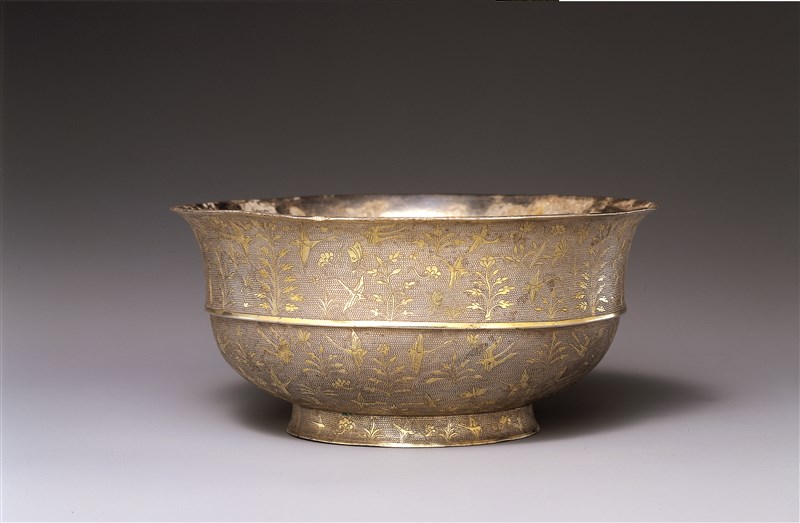Bowl
- China
- China, Tang period
- Late 7th to 8th centuries
- Silver gilt
- H-6.8 D-15
Catalogue Entry
Pieces like this silver-gilt bowl are the result of an old Near Eastern vessel form being transformed by Tang Chinese metalworkers. A similar bowl shape, without a foot ring, appears on a sixth-fifth century-B.C. carved stone stairway at Persepolis, and a slightly later glass example was found in the Treasury there.1 Exactly when such bowl shapes made their way into China is unclear, but a Near Eastern silver example unearthed at Datong in Shanxi province dates from the Northern Wei dynasty (A.D. 398-534).2 This metal version is also footless with a centrally placed raised ridge. During the Tang period (A.D. 618-907) this bowl shape, with a foot ring, became a form popular with ceramic and metal artisans alike.3
The Shumei bowl was hammered into shape from a single circular piece of silver and fashioned with a flared lip. A band of silver was shaped into a tapered-shaped foot ring, then soldered onto the bowl base.4 The protruding ridge line, encompassing the middle portion of the bowl's belly, was formed by hammering or chasing a thin line on the bowl's interior. The line appearing on the bowl's exterior was first scraped to form a sharp ridge, then gilded. The upper and lower bowl surfaces feature familiar Near Eastern chased and gilt designs of birds, tree of life motifs and floral sprays, in addition to butterflies, a favored Chinese motif.5 A ring-matted background, fashioned to be the same relief height as the chased designs, patterns the remaining bowl surface. The exterior surface of the bowl foot is also decorated with a single register of chased and gilt birds and floral motifs.
A gold footed bowl without decoration was excavated from the Xi'an area at the Northwest Medical Apparatus and Instrument Factory site.6 Several plain silver examples has been unearthed at Hejia village, and a lobed version, with tree of life motifs and birds holding floral sprays in their beaks, has been excavated at Sha'po village.7
In the West, the Pierre Uldry collection has a version similar in shape; however, this vessel features different floral motifs, and the entire piece has been gilded.8 The Minneapolis Institute of Art also has a comparable example,9 as do the British Museum and the Hakutsuru Art Museum in Japan.10
JMS
1. Stairway: see Ghrishman 1964, p. 177, pl. 223; Treasury: see ibid., p. 260, fig. 547. This bowl shape can also be found in sixth-century B.C. Greece, and a silver example was unearthed at the Hera Limenia sanctuary at Perachora (see Payne 1940, p. 150).
2. Buddhist caves at Yungang, situated just outside of Datong, reflect Indian, Iranian, and Roman-Byzantine art influences. On the excavated Near Eastern bowl see Wenwu 1972.1, pp. 83-84, p. 91 for fig. 28.
3. He 1989, pls. 320, 325.
4. Technical information courtesy of Pieter Meyers and Richard H. Kimball.
5. The tree of life motif can be traced to Mesopotamia, where it was believed that plant life had god-like qualities. For information about the motif and its importance in Assyrian art (c. 1350-1000 B.C.) see Frankfort 1970, p.135-37.
6. Li and Shen 1995, p. 24.
7. Han Wei, ed. 1989, pls. 118-119; see also Wenwu 1964.6, fig. 1.
8. Uldry 1994, pl. 144.
9. Gyllensvard, fig 1a, pl. 5.
10. Metropolitan Museum 1996, p.152.
